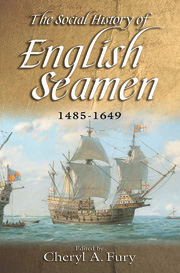Book contents
- Frontmatter
- Contents
- Illustrations
- Contributors
- List of Abbreviations
- Introduction
- 1 The English Maritime Community, 1500–1650
- 2 The Work of G.V. Scammell
- 3 The Men of the Mary Rose
- 4 Tudor Merchant Seafarers in the Early Guinea Trade
- 5 The Elizabethan Maritime Community
- 6 The Religious Shipboard Culture of Sixteenth and Seventeenth-Century English Sailors
- 7 Health and Health Care at Sea
- 8 The Relief of English Disabled Ex-Sailors, c. 1590–1680
- 9 Seamen's Wives and Widows
- 10 Jacobean Piracy: English Maritime Depredation in Transition, 1603–1625
- Conclusion
- Bibliography
- Index
5 - The Elizabethan Maritime Community
Published online by Cambridge University Press: 05 September 2013
- Frontmatter
- Contents
- Illustrations
- Contributors
- List of Abbreviations
- Introduction
- 1 The English Maritime Community, 1500–1650
- 2 The Work of G.V. Scammell
- 3 The Men of the Mary Rose
- 4 Tudor Merchant Seafarers in the Early Guinea Trade
- 5 The Elizabethan Maritime Community
- 6 The Religious Shipboard Culture of Sixteenth and Seventeenth-Century English Sailors
- 7 Health and Health Care at Sea
- 8 The Relief of English Disabled Ex-Sailors, c. 1590–1680
- 9 Seamen's Wives and Widows
- 10 Jacobean Piracy: English Maritime Depredation in Transition, 1603–1625
- Conclusion
- Bibliography
- Index
Summary
The Elizabethan maritime community was experiencing great stresses and strains but so too was it flourishing. The age of European commercial and geographic expansion defined much about English seamen's circumstances in the late sixteenth century as did the naval and privateering war with Spain. Even in the face of these new demands and opportunities, for the most part, seamen and the state tried to preserve the status quo. In some ways, these ‘craftsmen of the sea’ were typical of early modern labourers:1 they fought tenaciously to protect their customs and traditional practices whether or not change was in their best interest. The fact that much remained the same about seamen's experiences for centuries is a testament to the longevity of those customs. This is not to say that change did not creep in, as seamen were faced with a host of challenges in a Europe fractured by competing religious and commercial interests as well as their introduction into a much more global, hazardous and volatile workplace.
The maritime community at sea
When I was writing my Master's thesis, I was castigated by one of my profes-sors for painting the English seafaring community as an ‘amorphous blob’. We historians like to put people into tidy categories but we recognize that these are often artificial constructs. Such is the case with this group of maritime labourers. Although some seafarers were very specialized, there was a high degree of traffic between the various sectors of the maritime community.
- Type
- Chapter
- Information
- The Social History of English Seamen, 1485-1649 , pp. 117 - 140Publisher: Boydell & BrewerPrint publication year: 2012



